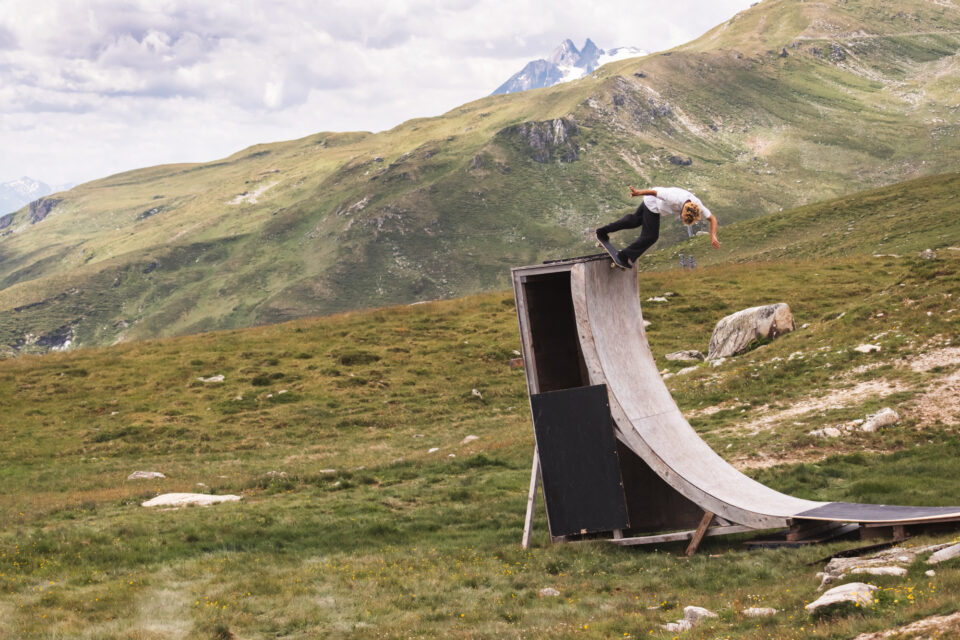Previous post
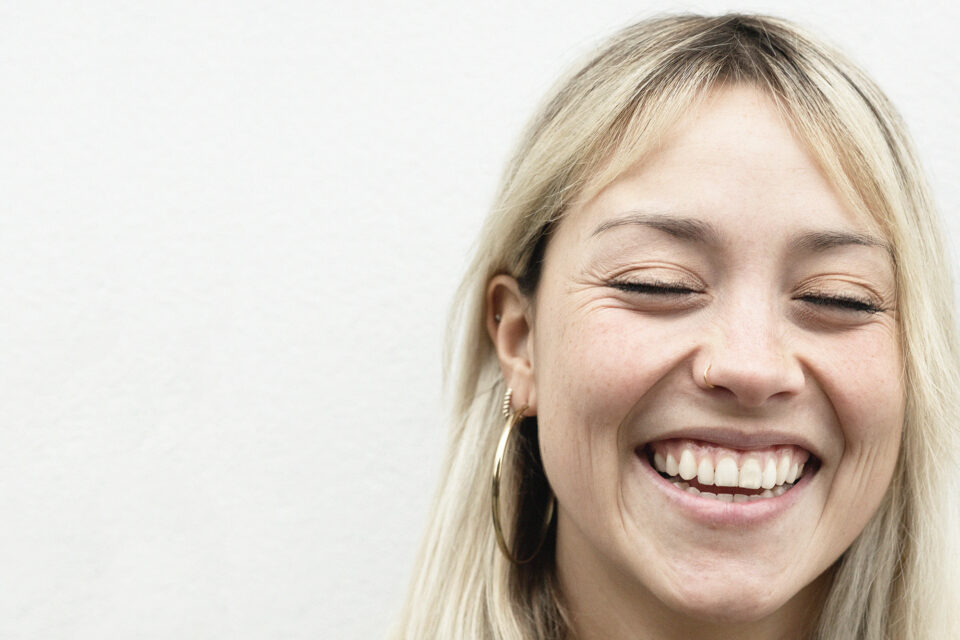
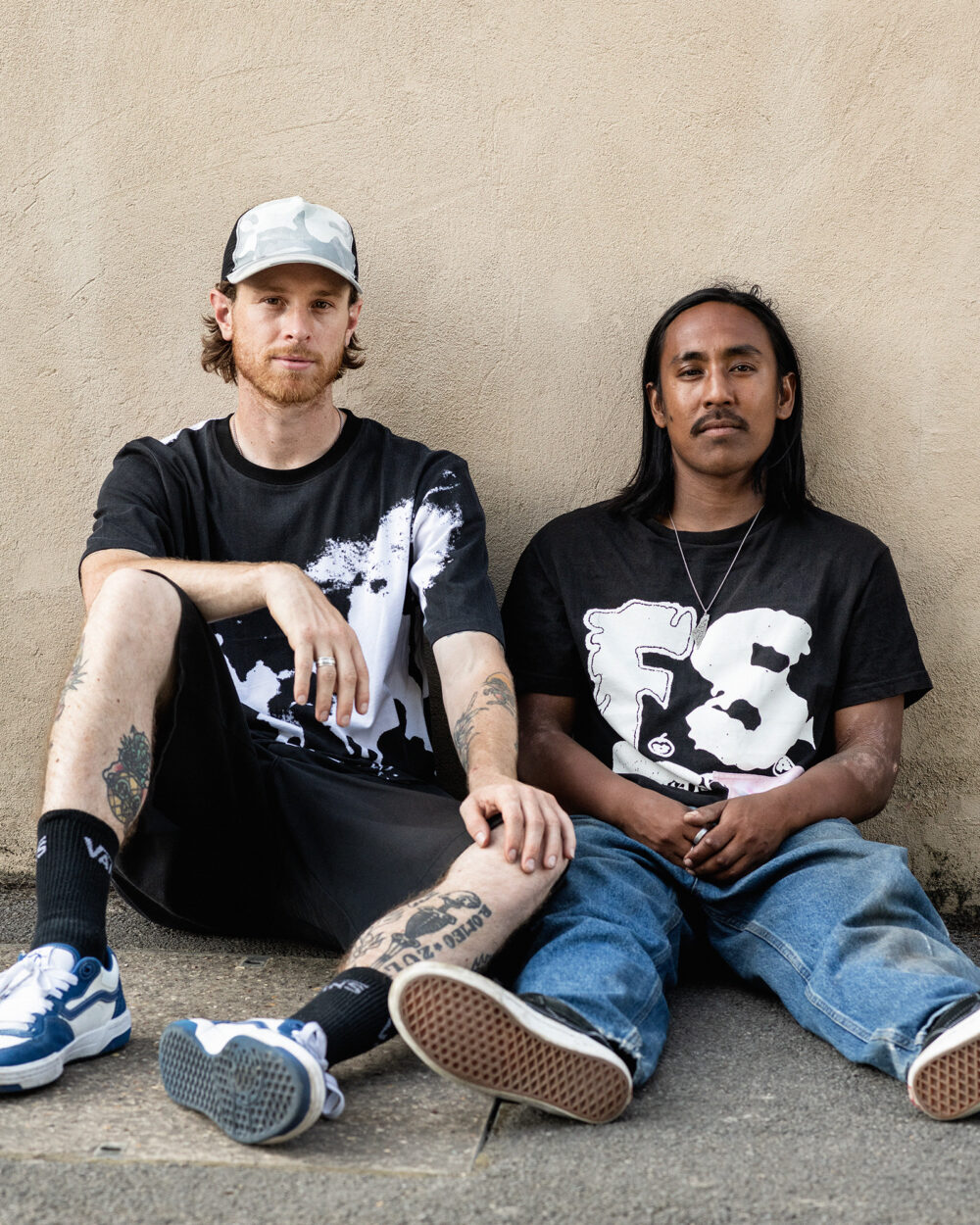
Interview & portrait: Genualdo Kingsford
Where did you both grow up?
D – I grew up in Harrow, north-west London.
T – I grew up in south-east London, between Greenwich and Lewisham.
For anyone unfamiliar, tell us about those places.
D – Harrow is very much a suburb of London, but it’s still really close to it. It was very green, it had its own town centre… it was its own place, but still very accessible into the city.
Harrow has a lot of skate history.
D – Yeah. Harrow Skatepark is one of the oldest skateparks in the UK. When I grew up skating there was Ross McGouran, and Death Skateboards had the Death House just up the road from where I lived, so I was always around a lot of skating.
T – With skating, I’d just hang out in Deptford the whole time. My best friend lived there and we would just skate around his area. I met Fos (Mark Foster, Heroin Skateboards owner) quite early on. He lived in New Cross. We used to go to his house and buy boards off him for cheap and hassle him. We were all really into Heroin Skateboards. We loved the videos because they were quite playful.
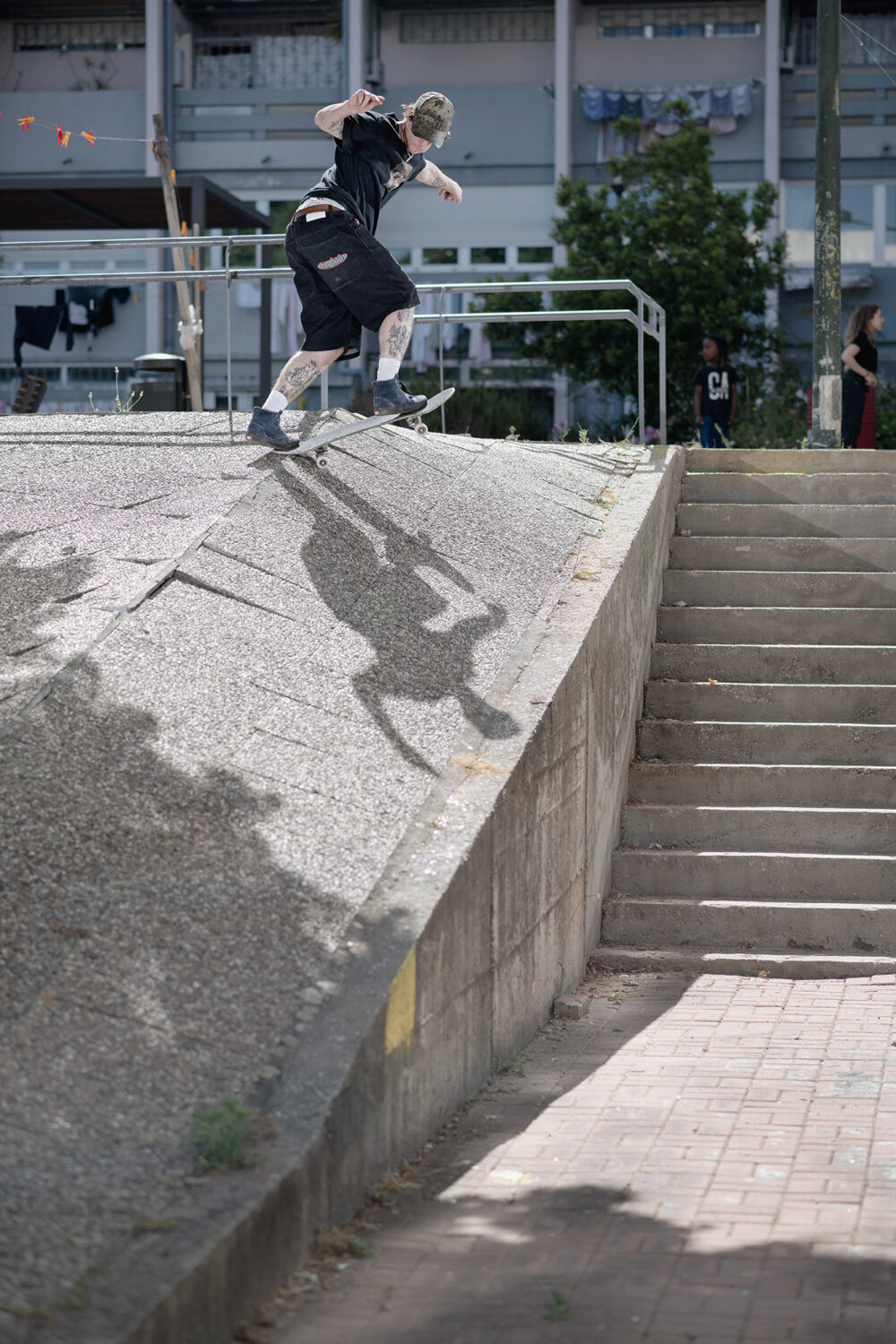
What era Heroin was this?
T – Live From Antarctica. We were heavy into that video. Louie Jones – who’s from around here – had a section. He was a friend of a friend and we met him a bunch. He was really gnarly, trying to backside flip huge stair sets and stuff. We just thought that was the sickest shit.
Me and Daryl started skating the same year, I think, but on opposite sides of London. Harrow and Lewisham are probably quite similar in terms of their proximity to central London and the fact that they’re both quite green, leafy areas, but they also have really strong identities. I’ve got a strong connection to where I grew up because there are strong music and art scenes, especially in Deptford and New Cross. There’s a lot of history and collective unity against racism, fascism and a strong emphasis on dub, reggae and punk music.
D – A lot of movements. Harrow doesn’t have that at all.
T – Yeah, movements, exactly. Things that are from my parents’ era that I grew up being aware of and that helped me have that connection to the place.
D – That’s why you stayed, whereas I’m always trying to find somewhere else. Because other than my friends and family and whatever… that’s all that really kept me in Harrow. As soon as I left, I felt no need to go back, whereas you’re quite rooted in where you are because it has all these things that obviously nurture you.
And you’re currently living in Camberwell, Daryl?
D – I’m in Camberwell. I haven’t lived in Harrow since 2015.
So going back a bit, am I right in thinking you were a Baysixty6 local, Daryl?
D – A Harrow / Baysixty6 local, yeah.
T – I was not a skatepark skateboarder. I only skated street until I went to university in Brighton. I learned to skate transition after they built the Level and I started skating there with Rich West. Actually, I kind of stopped skating when I went to university, and then they built that park in my third year and I got heavily back into it. I guess it’s interesting that me and Daryl have had very different skate trajectories. I didn’t get sponsored until I was about 26 and he was sponsored when he was 15 and has been ever since.
Do you remember the first time you met?
D – I feel like we would have crossed paths at Bay on a random one.
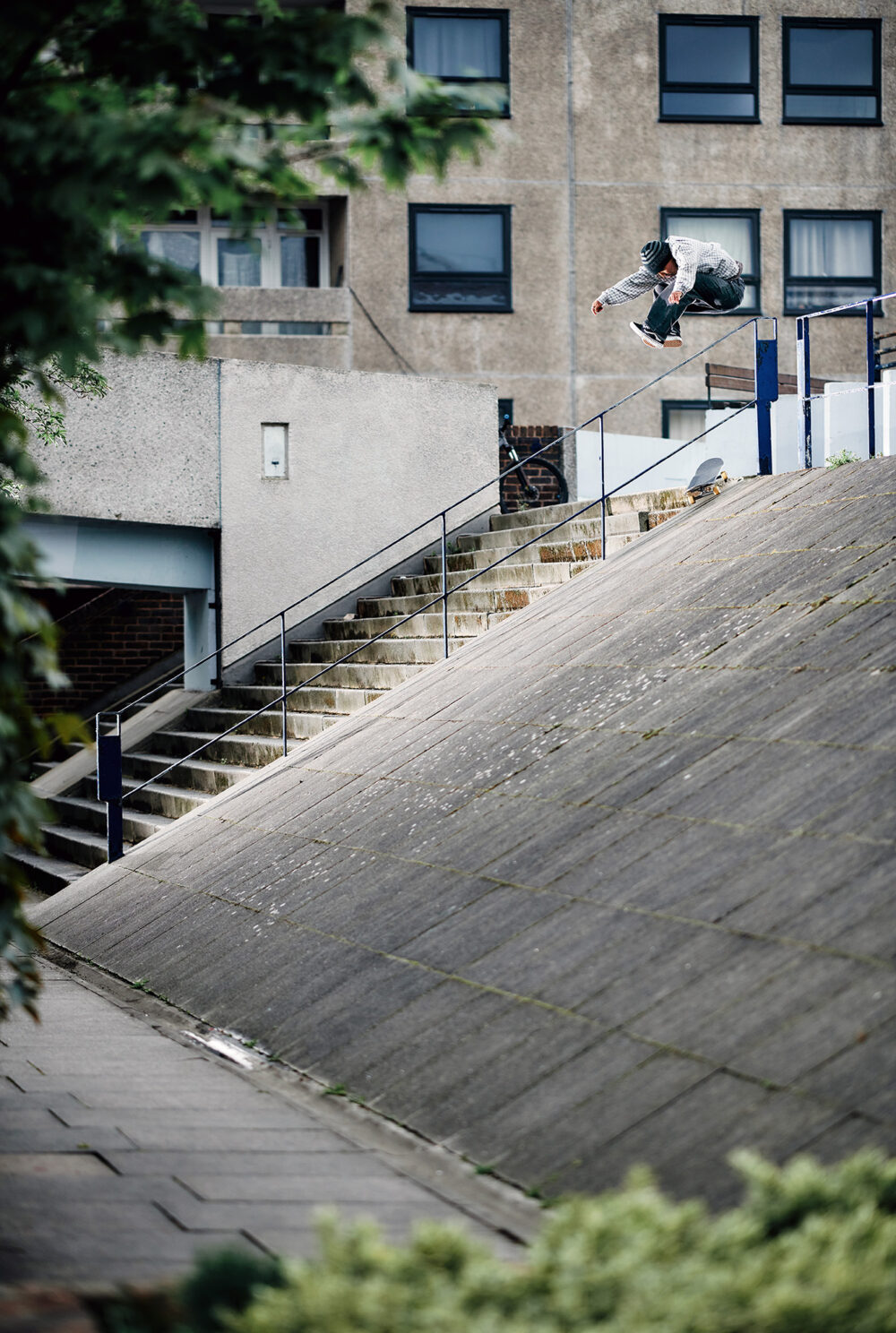
Were you aware of each other back then?
T – I was aware of him. He wasn’t aware of me. Everyone knew Daryl because he was Kickflip Daryl.
D – You knew Henry (Edwards-Wood). At one point the Hold Tight videos held a lot of the scene together. I filmed a lot of stuff with Henry.
T – I remember seeing you in those videos. After me and my crew stopped being really into Heroin Skateboards, Hold Tight London videos changed everything for us. It was raw street skating and they featured who we thought were the best dudes at the time, like John Tanner, Shaun Witherup, Lucien (Clarke) and Rory (Milanes). My little crew of skaters would watch the videos and then go to the spots they were skating and try and do tricks.
So back to your first meeting…
T – That was way later, in 2016. We were out filming with Austin Bristow.
D – I was filming a part with him.
T – I was working on those Regulate edits he made for Jenkem, which were actually my first clips on the internet that got any recognition, so shout out Austin. I’d just come back from Nepal, where I’d gone to do this photography project with my friend Gaurab (Thakali).
D – And I had been to Nepal just after you’d left, backpacking with friends.
T – And we’d met all the same people. We bonded over that. I’d gone there to find skateboarders and connect with them, and he had gone there and met these same kids. We decided to start the non-profit organisation, Skate Nepal.
So you started Skate Nepal soon after meeting for the first time?
D – As soon as we knew each other.
T – I think we were pretty shocked by the synergy. I hate the idea of fate, but it was fateful that we both had the same idea in mind. We’d only just met each other, but it made sense.
D – And Gaurab is Nepalese and he was really down, so we all started that together.
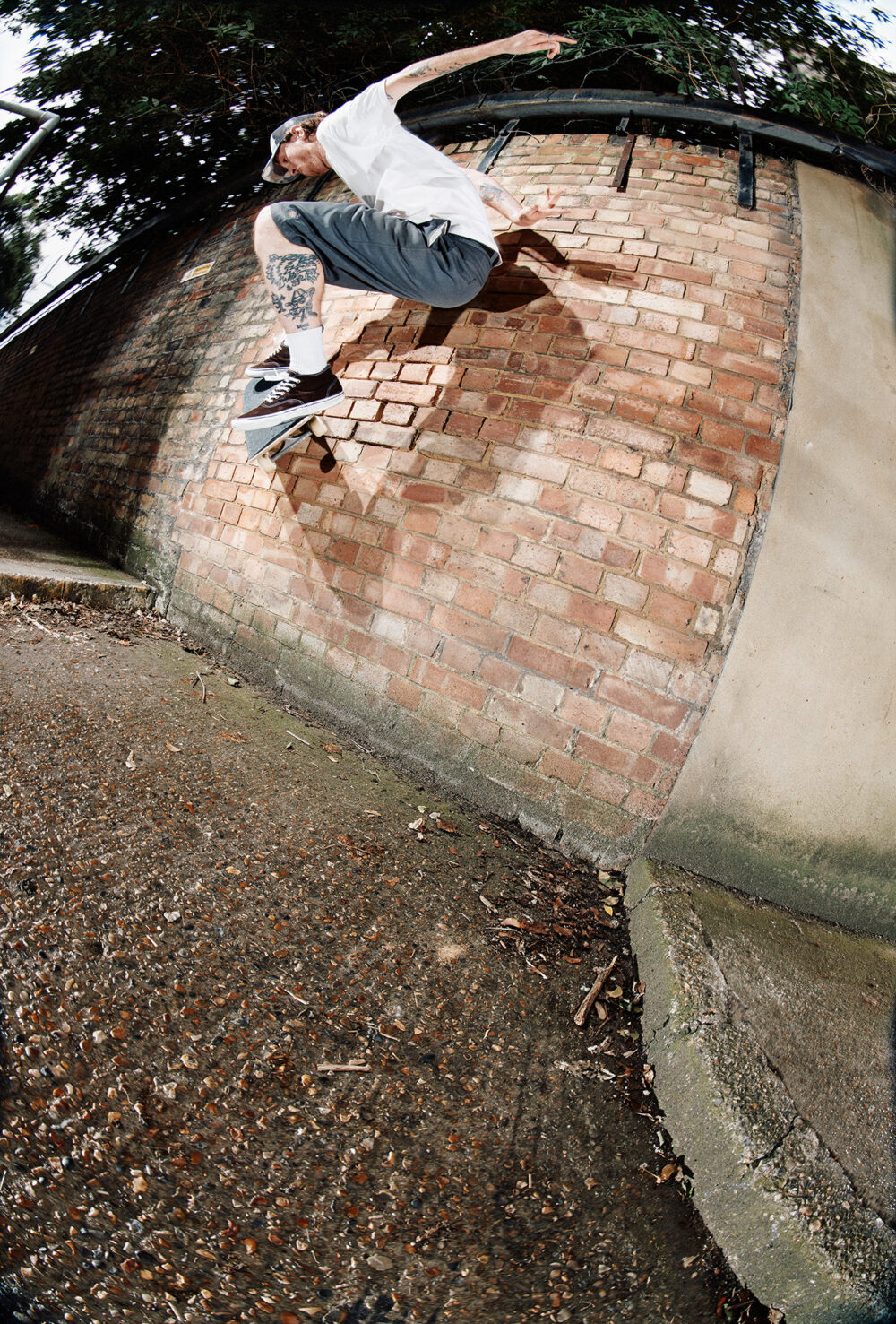
For anyone unfamiliar, what is Skate Nepal?
D – It’s a non-profit organisation that aims to nurture the skate community in Nepal. At the time we started it, there was only one very ragged skatepark and now there are two very good ones: the Annapurna Skatepark in Pokhara and one in Butwal, built by Skate-Aid in 2022.
T – There were three at one point.
D – There was one in Kathmandu, which was smaller – it was more like a tester – and then in Pokhara, in the foothills of the Himalayas, they got more land, and Make Life Skate Life built a massive park.
T – When we first went there, we met this guy called Ram (C Koirala), who said he was the first Nepalese skater. He had just built this little concrete park on his own – which I found – and a couple of kids were skating there. We just wanted to give them the tools to nurture that, and just help them however we could.
D – We just wanted to promote skating. The first fundraising thing we did was to extend that skatepark. I went there after, to do workshops for local kids. Loads of them came and they were really eager to learn, so I thought: “OK, there’s scope for this.” Then eventually, loads of very organic things happened, like Make Life Skate Life being there the second time I went, so I linked up with them. We all worked together, just constantly fundraising, and that skatepark got built in Kathmandu. Then the big skatepark – the Annapurna Skatepark – got built in Pokhara. After that, it was about sustaining the scene: trying to get equipment over there, because they didn’t have access to goods, trying to make sure there were skaters on the ground who could teach – we mentored them in terms of how they could teach – and we helped them set up skate shops, stuff like that.
T – But it was also a steep learning curve for us. We learned a lot and we feel like we saw the skate community grow from this tiny little scene into a flourishing thing. Then in 2018, we went back with Vans, Lovenskate and Carhartt. We did this trip all over Nepal, filming skating and doing demos. We brought so much donated stuff, so every stop on the way, we gave out boards, shoes, wheels, trucks… everything. I’d say it was quite a life-changing experience, actually.
What’s going on with Skate Nepal these days?
T – We kind of wound it down because we felt that we weren’t really necessary any more. They’re self-sufficient now. We both want to go back to Nepal to see how it’s grown, but they’re doing it now. All these kids that we saw getting into skating, some of them are travelling, some of them are competing for Nepal, some of them have sponsors…
D – There’s an annual contest in India that they go to.
T – They’ve come from a place where they wouldn’t expect to do all that travelling and all that stuff and now they have a life in skateboarding.
D – That’s kind of the main reason, but the second one is that as you get older, you become aware that you do a lot of this work for no money, just for the love for a community that you want to help. Obviously, you have to prioritise your own time so that you can sustain yourself, and it gets to a point where you have to decide: “OK, I make this a job now and I grow it and expand it, or I keep it where it is.” It just happened to be at a point where it was self-sustaining. I’ve always been passionate about nurturing skateboard communities. I started riding for the Philippines Olympic team and last year I was asked to coach. I used that as a vehicle to essentially do the same stuff for skateboard communities in the Philippines through Push Philippines, so I’m more focused on that now.
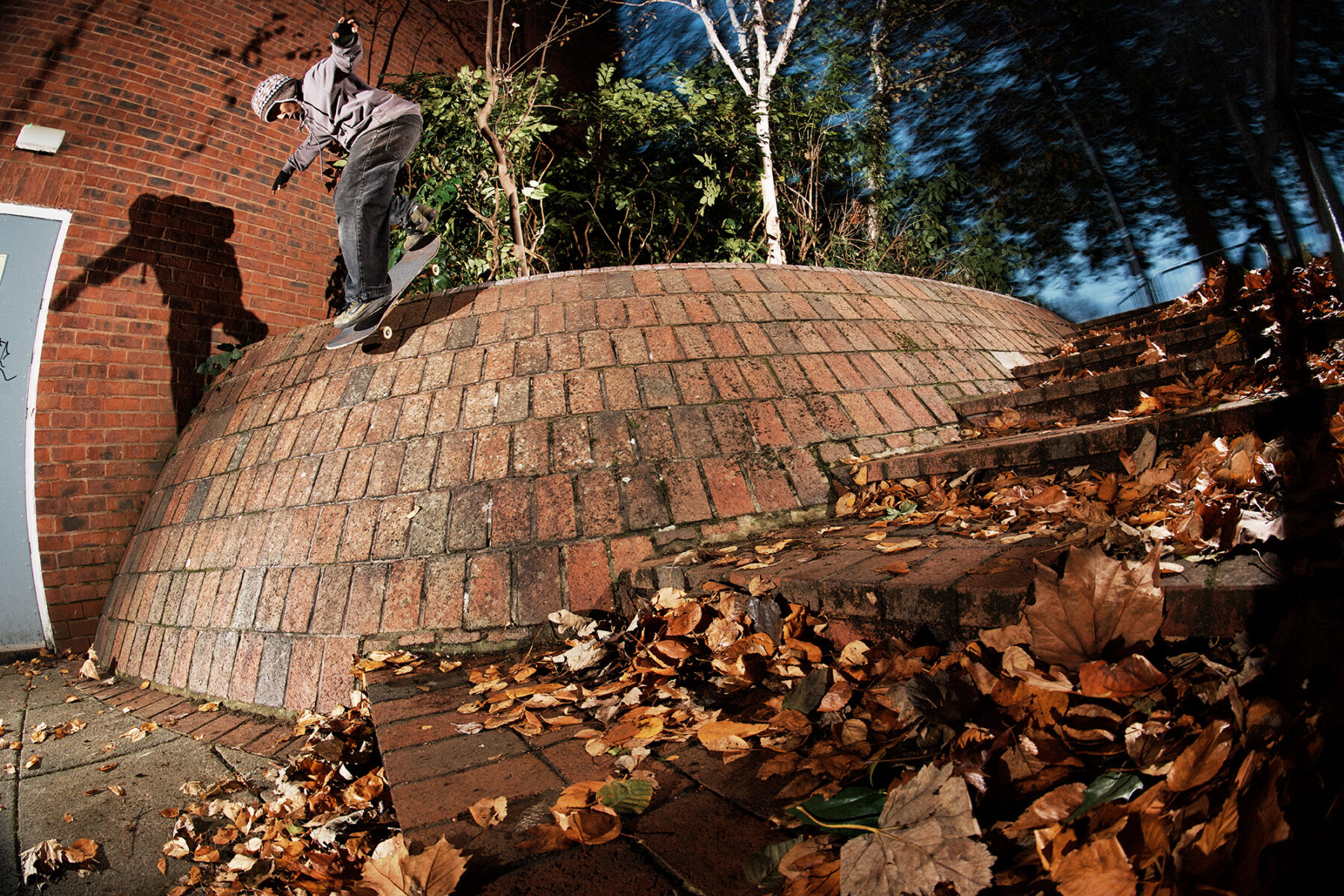
Tell us more about Push Philippines.
D – At the core of it, Push Philippines is the same thing we were doing in Nepal. We’re helping nurture the skate community in the Philippines. It manifested with me meeting a friend called Emilio (Molave). My relationship with Emilio is super similar to how our friendship started. He hit me up because he saw what I was doing with Nepal. He was like: “It’s really sick what you do there, I want to do the same with the Philippines.” Emilio’s dad is Filipino.
T – Maybe we should also clarify, because you haven’t said it in this interview, that you are fully Filipino.
D – I am, yeah, and I’m very invested in that. Obviously it’s where my parents come from, and telling your parents that you skate for the Philippines Olympic team… They couldn’t fathom it. They were just like: “What? How does that work?”
And now you’re coaching, as opposed to being on the team?
D – I’m coaching. When I was on the Philippines Olympics team, I had two coaches. One was Ant Claravall, who is a very well-respected figure in the skate world, and the other was Dani Bautista. Dani films and lives in the Philippines. He’s been in the skate scenes in Hong Kong and the Philippines for a really long time. So we started doing this thing together, both (Daryl and Emilio) working with Ant and Dani. We started a donation programme and we were really overwhelmed by the number of people who were donating.
T – Explain the shipping situation.
D – There’s a custom within Filipino culture called balikbayan, which basically means sending goods back home to the Philippines. It’s a cargo set-up where you can send these different sized boxes by sea freight to the Philippines. They get there two or three months later, but it ends up being really cheap, so we can send something like 110-130kg of skate stuff each time. After the first shipment, we had so much left over that we were like: “Oh, we can keep doing this. Let’s commit to sending a box every quarter of the year.” Because I have been in the skate world so long, I have good relationships with a lot of people who work at distributions and brands, and they’re really happy to donate.
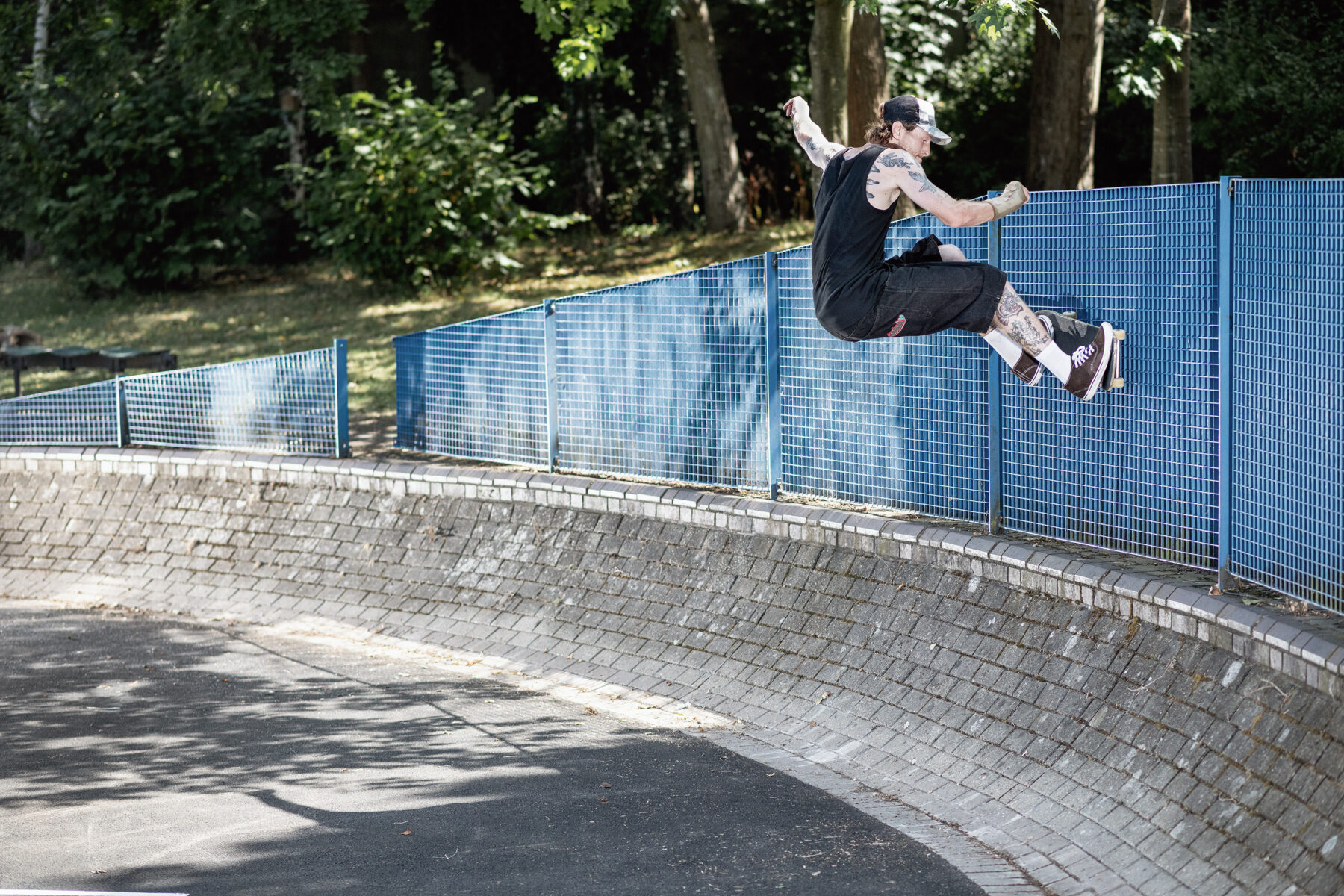
Can you explain the need for these donations in the Philippines?
D – The minimum daily wage for someone in the Philippines is like £5-8 a day, but a lot of skate stuff is imported and it’s the same price as here, so the common person in the Philippines can’t afford it. But skateboarding is really popular there due to people like Margie (Didal), who’s this Filipino sensation. Margie has broken through into the international skateboard industry as someone from the Philippines, and is a role model to lots of people, not just skateboarders, but to young generations of people in the Philippines wanting to start skating. Dani distributes these boxes to different pockets of skate communities around the Philippines, and through that, he gets to understand them and see local talent. Every single place he goes, skateboarding’s really popular. People are still skating in flip-flops or skating boards without a tail, you know? So you have this climate where everyone wants to skate, yet it’s not affordable.
Tell us more about skating for the Olympic team, Daryl.
D – I got a name for myself in skating through skating comps from when I was 15 up until god knows when. Contests were quite serious for me at the start because my parents couldn’t fathom how you would make a living skating. I had this quite weird pressure to be like: “I’m bringing home some cheques,” so that they could trust my lifestyle choices. For me it became this thing, but I think I just got to a point where the culture of filming video parts, shooting photos, going on trips and meeting new people became way more important. I realised that’s what I loved about skating. So when I got asked to skate for the Olympic team in 2019, I really wasn’t a contest skater, but at the same time, it was Ant Claravall asking me. He’s done so much for skateboarding and he’s just really respectable, so I was like: “Maybe I should consider this.” He came to one of the Street Leagues, we had a chat, and it was really cool because he made it less pressured. He was like: “Look, it’s more about representation. It’s not about having the most elite team.” He explained that if skate-boarding is well represented, then people in the Philippines will have a view of what it means to skate, instead of: “Here’s an elite set of athletes.”
If anyone else had asked me to do that at that point in my life, I probably wouldn’t have done it, but because it was him and I really trusted his vision, I was able to get on board with it. I got on just before Covid and I skated one contest, the SEA (Southeast Asian) Games, which the Philippines was hosting. It’s basically the Olympics of (south-east) Asia; it’s a very big contest. We ended up winning every category, which was good in terms of opportunities for everyone on the team at the time. Even though I didn’t win myself, it was just really good and I was like: “OK, I’m going to start doing this again.” But then obviously Covid happened and it was a bit of a grey area. I didn’t skate comps and life kind of went on as normal.
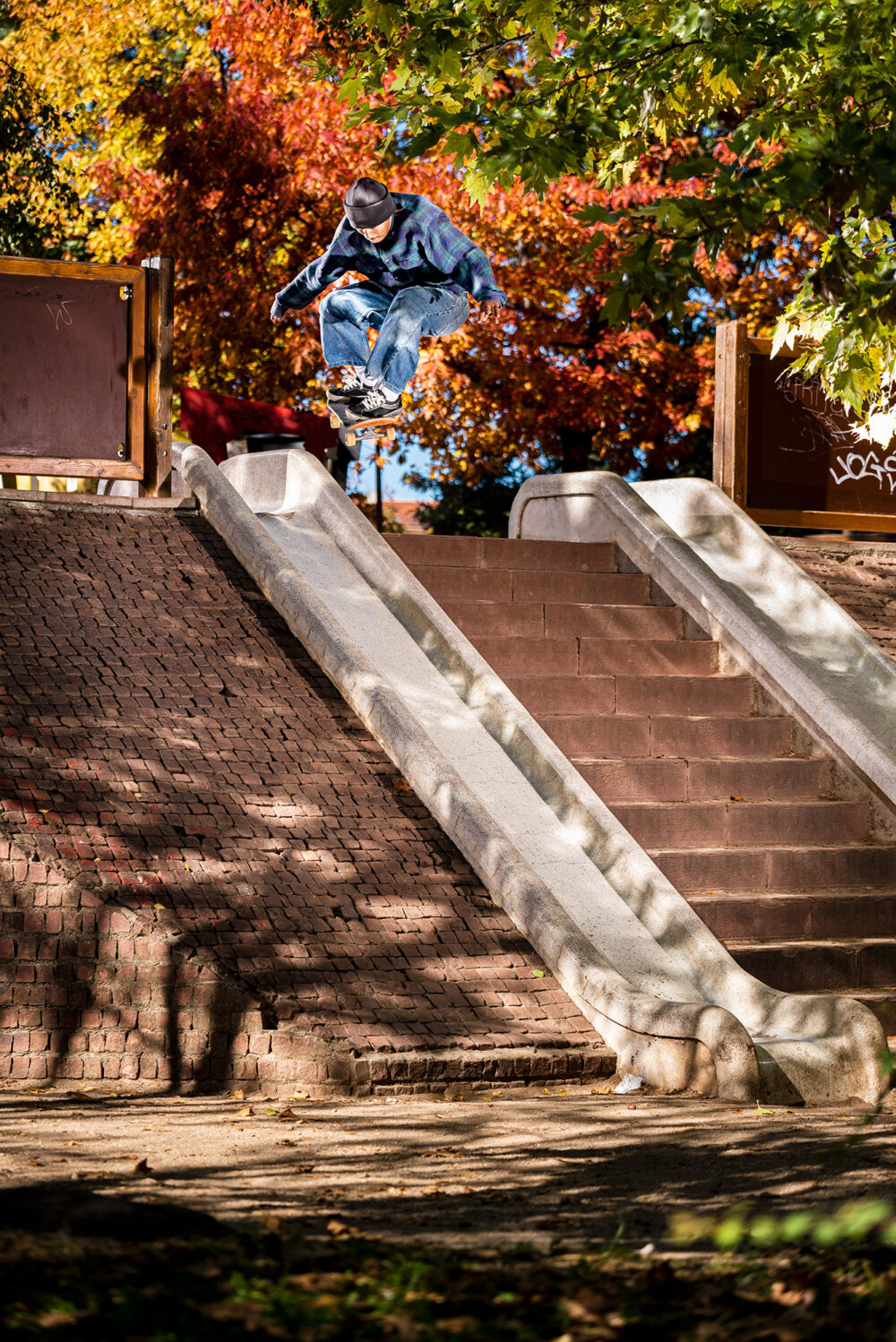
But you were still on the team.
D – I was on the team, but I wasn’t really doing anything. When it got to the Olympics in 2021, I realised I hadn’t been to enough comps to even have the points (to qualify). Eventually I was like: “I haven’t skated a contest with you guys in ages. I kind of don’t really want to skate contests any more,” and they said: “That’s fine. Why don’t you coach?” I felt that was a really good opportunity.
Tell us about your role as an Olympic coach.
D – We do training camps and we go to contests. Leading up to Paris for example, over three-four years as an Olympic athlete in skateboarding, you go to all the contests and you basically rack up points. At the contests, you’re really working with them, trying to get a rapport with the skaters you’re representing. And the training camps… the head coach – which is what Ant was doing – organises where we need to be and at what time. He does the more logistical, organisational stuff. I was brought in to work with the skaters on technique and ability, piecing lines together, stuff like that. I’ve taught skateboarding for 12-13 years over varying degrees of ability. It’s something I quite enjoy doing, like the technicalities of working with people to help them achieve something. That feels quite fulfilling.
So you don’t need to be based in the Philippines to coach the Olympic team.
D – No. The training camps very much took place on these trips. The Philippines doesn’t have the infrastructure, like the right facilities for training. A lot of the riders would have to travel for a training camp anyway. And also, half the team is Filipino-American, Filipino-German… They aren’t all necessarily based in the Philippines anyway.
Moving on, as I understand it, you both earn some money from skating, but do other work to supplement that income. Run us through what work you both do.
T – I’ve always done freelance photography work as well, and for years I worked for Yardsale. I guess my official title was head of distribution, so I was talking to skate shops, getting the stock in a lot of places and trying to organise distributions in other countries. That really gave me an insight into the industry, how product sells, what does well and how things work in terms of where the money comes from in skateboarding. I started my own company (Baglady) over Covid, and to supplement that and other stuff, I’ve been teaching skating as well. Daryl got me that work.
You’ve both been teaching today.
T – We’ve been teaching today at these workshops with UCL (University College London) down at City Mill. Actually, I was just saying to Daryl how rewarding that is. We’ve got people who had skated a little bit, but had no confidence before, and now we’re three days into the week-long workshop and they’re all going for it, learning stuff.
D – I do other jobs as well, though. From quite a young age, I’ve always travelled through skating and having a full-time job would have sacrificed that. I got around that by having a lot of freelance jobs, which allowed me to stay flexible and go away when I wanted. Teaching skating is one of those. I’ve been working for Dave Chesson (Learn to Skateboard) since 2017 – that’s the one me and Tom do – and I’ve been doing skate camps at Baysixty6 since 2011 or 12. I’ve also worked for King Ramps since I was 18. That’s Pete King’s ramp company. It’s one of the older ramp companies in the UK. I do loads of different things for them.
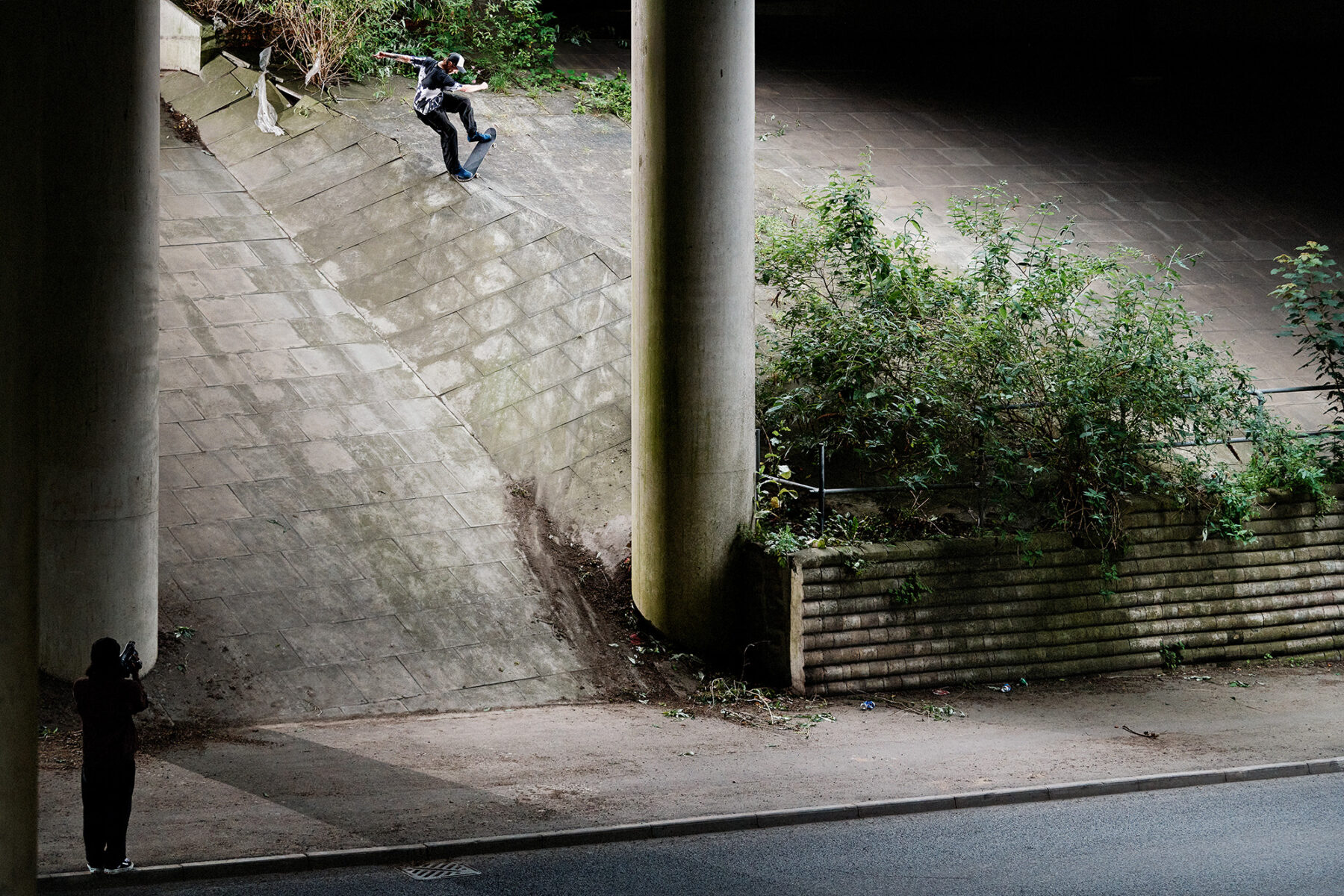
Was it ever your goal to make a living exclusively from sponsored skating?
D – When I was younger, I was like: “Yeah, that’s the goal… that’s what I want to achieve,” but a lot of maturing led me to realise that there are more important things than that. It’s really good to be goal-driven, but you don’t want to be so goal-driven that you miss the beauty of what you’re doing. The possibility of that is also dependent on your circumstances. I was never on board companies where I could ever see that happening. But I was kind of promised that for quite a long time. I feel like a lot of people are.
T – They’re promised this thing, but they’re just led on forever. That was one of the motivations for starting my own company.
D – I basically gave up the whole American dream thing around 2020. I was getting Alien Workshop boards through Shiner. The part that I filmed with Nick (Richards) that ended up on Free – the Pissing Grounds part – was supposed to be an Alien Workshop part. That project was three years in the making. When I started filming it, they (Alien Workshop) were like: “Yeah, that’s what we want. Let’s try to get you out.” Then loads of things happened, like Covid, and they changed distributions, so direct contact with the brand just kind of got lost. Ultimately, towards the end, they just weren’t interested. I thought: “I have a whole part. If I’m going to try to find somewhere else, now is probably the best time.” There were a lot of options on the table, but I just couldn’t see myself anywhere where I felt I belonged. This was all around the time you were starting Baglady and we were filming Pack Light. When we were filming that first video, there was no talk of boards anyway.
T – I was just making clothes and we decided to start filming. We were all skating blank boards or a mix of boards. I think I got my first run of (Baglady) boards around the end of the video. Coming back to the original question: do I see myself becoming a pro and all that stuff? Well, I’ve kind of killed that dream because I can’t turn myself pro. I’ve had such a different trajectory (to Daryl). I’ve always had imposter syndrome as a sponsored skater. As I got older, and from working for Yardsale, I think my idea of what a professional or a sponsored skater has… I have really high expectations, which is unlucky for the people who ride for Baglady (laughs).
Tom, can you talk a little bit about how you put the Baglady team together? Was there any drama with your riders’ previous board sponsors?
T – The thing with the team is, obviously I have to like someone’s skating, but I also have to like their personality. I really like everyone on the team as a person and we get on. That was the most important thing for me. In terms of people riding for other companies, everyone was sort of homeless in terms of a board brand, which was why the people who are on felt so right and organic. Obviously we know Daryl’s story. Davide (Holzknecht) was also criminally underrated at the time and needed a board sponsor. He really wanted me to make Baglady into a board brand. His career is blowing up, but he believes in it, which is really validating for me because he’s one of my favourite skaters. Henry Gibbs is quite new to the world of sponsored skating. He gets Nikes and Aces, but he hasn’t had another board sponsor. Henry’s skating is sick; you never know what you’re going to get – it might be a golden clip or an epic slam. Joel Banner was getting Krooked flow…
He spoke about that in his interview in our last issue.
T – I think when you get a little bit older, you understand the value of being part of something that you’re creating from fresh. Joel understood that and was down to start getting clips for the first video straight away. And then Aref (Koushesh), who is officially my favourite skater, had footage in the first two videos and I really wanted him to be a part of it, but he’s just not really interested. He’s got a career now – he’s an osteopath – so I felt bad trying to force him to film stuff. The newest person is Tom O’Driscoll, who lives in Norwich, but lived in Sheffield for ages. He’s just got a completely magnetic personality and a great approach to skating.
Tom, could you talk about how you handle the workload associated with running a brand? Baglady is still a relatively small operation, yet a lot is required of a board brand these days: regular drops, lookbook shoots, not to mention releasing skate videos regularly.
T – It sounds like a lot, doesn’t it? Well yeah, it is. I basically work three jobs for the company and then I also have to make money on the side. As I said, I teach teaching and do other freelance work, but when I’m not doing that, I’m in my studio designing clothes, literally packing the boxes… Sometimes I have help from people. I’ve paid people here and there, and luckily I have friends like Daryl who will help me out as a favour, but in terms of the workload, it’s a lot.
I want to get some full-time employees – that is how I want to grow the company. But yeah, I do all the designs, I do all the distribution stuff, I do the team managing, I manage making the videos and because I studied photography, I do most of the photography for Baglady as well, which leads me on to saying what the original idea for the company was: an amalgamation of all my creative exploits, but also a platform where I can work with friends, photographers and artists – people who I respect – and put their work on clothes or boards.
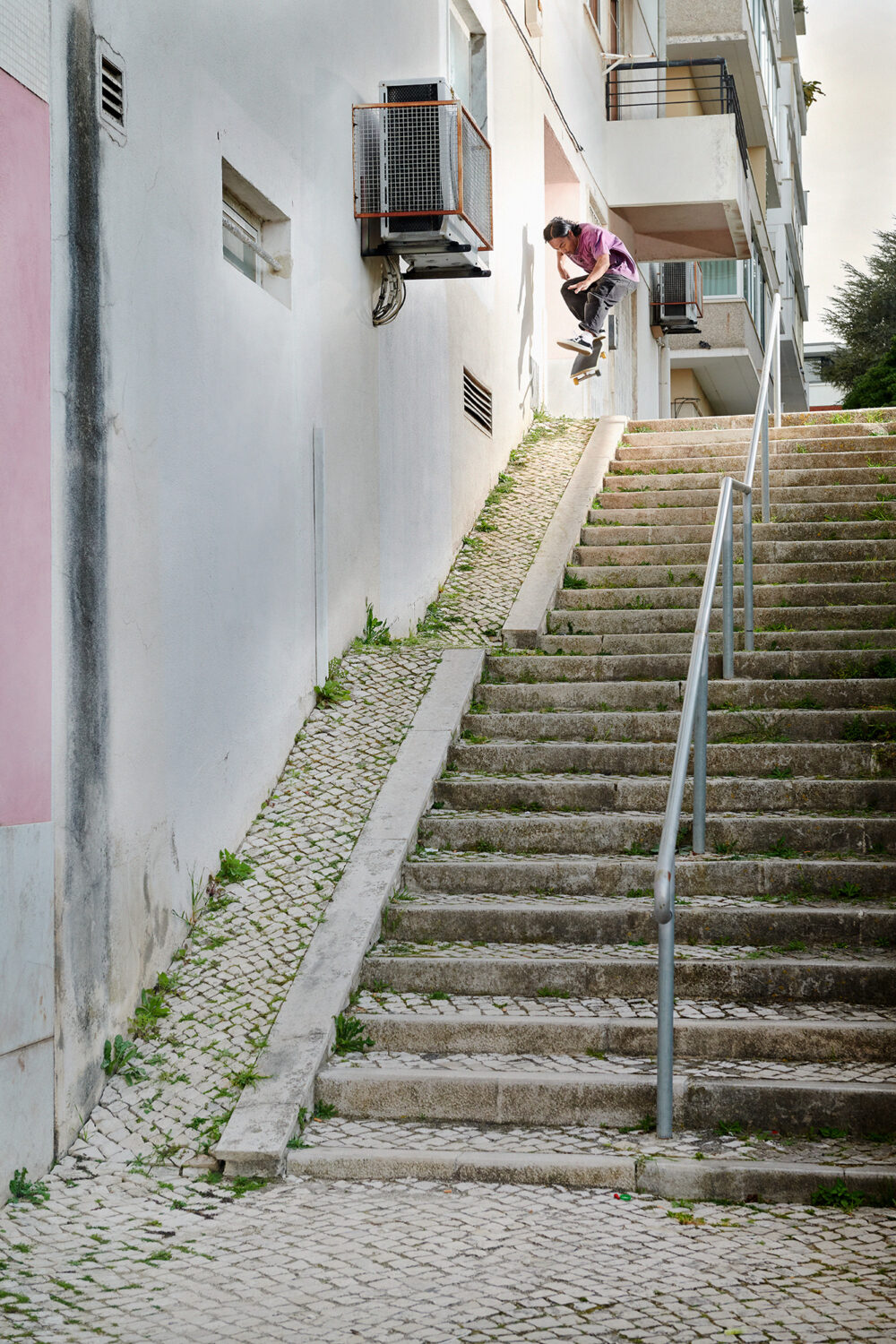
What are your plans for the future with Baglady, Tom?
T – At the moment, I’m doing three big drops a year and some smaller ones. I want to be able to work a bit further in advance, so that I can have four solid clothing drops a year. I want to do more events. I think there’s a lot of value in community outreach: putting on events, jams… Also, I don’t hide my political leanings with my company. I made a Free Palestine T-shirt to give money to charities in Palestine, and I want to do more things like that. It might isolate some people, but I don’t really care if those people are isolated because the company isn’t for them. When you really establish what the company is about and what your morals and ethics are, it gives people something they can really identify with. Another thing is to hopefully have our first pro skaters. I’ve waited quite a while, but I think that if we can do it, next year is the year. We’re also working on a video at the moment. I’m hoping this one will be the best so far in terms of quality and will really establish the aesthetic of the company and take it to the next level.
What are your longer-term plans for the future? Do you both see yourselves staying in London?
T – Yeah. I can’t really see myself living anywhere else, to be honest. We both grew up in London, so it’s part of our identity.
D – I spent such a long time away travelling. I spent six or seven years basically living out of a backpack. I’d come back to London every year for maybe four or five months before I’d be off again. It’s only recently, in the last couple of years, that I’ve felt quite grounded again. For me now, it’s about having some grounding while still being able to travel, rather than always being away. I would love to move abroad – me and my partner want to do that – but a lot of things need to marry up for that to happen.
T – For me, having the company in London… I mean, London is part of its identity. I’m very grounded here because of that. Also, I don’t really have any desire to move out of south-east London, even though it kind of breaks my heart what is happening here in terms of house prices and the way that all the things I like about this pocket of the city are being slowly faded out because of redevelopment. There are no creative spaces that haven’t been bought up by developers, but in a way, that makes me want to dig my heels in even more and stay here because it’s where I’m from.

